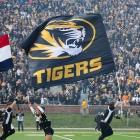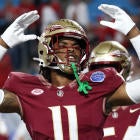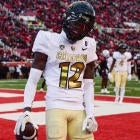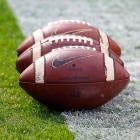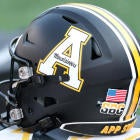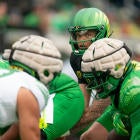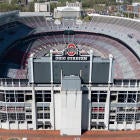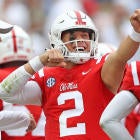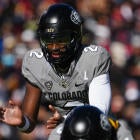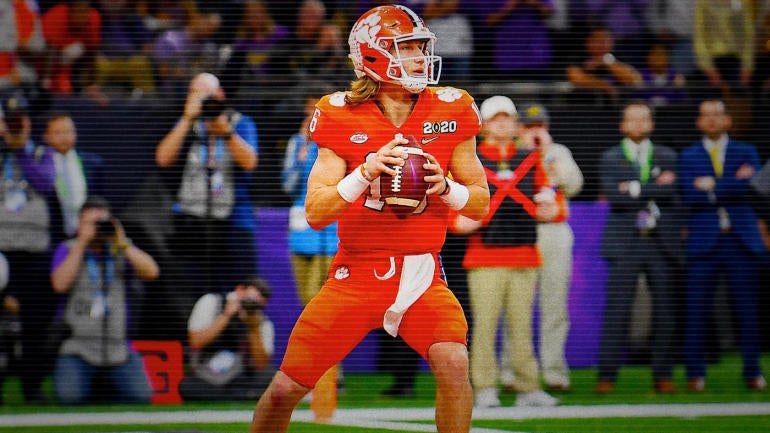
Quarterbacks, you might say, are as important now as they've ever been in the game. Think of it this way: No one is really sure what the 2020 college football season is going to look like. With spring practices having been canceled and preseason workouts only now starting back up, it'll be up to team leaders to help get everyone else up to speed.
Oftentimes, that leadership falls on the quarterback. They're responsible for making sure everyone on the offense knows their assignments. They're the field generals.
For the past few years, I've eschewed traditional quarterback rankings in favor of tiers. Putting quarterbacks in similar groups makes more sense because they can be better compared to their counterparts. As you'll see, players like Trevor Lawrence and Justin Fields are in a different stratosphere than just about everyone else. How they rank relative to each other is more applicable than how they rank compared to your average starter.
With that in mind, I tiered more than 50 FBS quarterbacks for the upcoming season based on their performances from last year, though career numbers were taken into consideration as well in the event of injuries, redshirts, etc. The results are below with some methodology explained first.
- Not every quarterback is ranked. This is a celebration of what certain players do well and there's a law of diminishing returns.
- Passing numbers are the primary focus. In the past, I included a QBs rushing stats to paint a bigger picture. While those stats will be considered when applicable, I dove deeper into what a quarterback (generally) does most: pass the ball. Efficiency matters, too. More isn't always better.
- Not every two-deep is going to be settled post-spring, but as a general rule, I omitted quarterbacks involved in heated offseason battles. If the picture is that unclear, it's tough to rank them.
- Experience matters more than potential. I'm going to rank players more on what they've done vs. what they could do, one year experience minimum. This seems obvious, but it's worth pointing out specifically when it comes to transfers like Justin Fields, a Tier V quarterback last year. I also didn't rank any player who has yet to take at least one snap in a college game. Looking at you, Bryce Young.
- Players could fit in more than one tier. There's obviously an order to the madness -- you would take a Tier I quarterback over one from Tier III every time -- but I ranked quarterbacks in tiers that felt like the best match. Keep in mind the order is a snapshot of the moment. It can and will change from year to year.
- The data is courtesy of Sports Info Solutions. Most of it is self-explanatory, but just in case: Air Yards represents, you guessed it, the number of yards the ball traveled in the air. AY/ATT is air yards per attempt. On-target percentage represents the number of passes that were catchable.
Tier I
All-America and award season aspirations, including the Heisman Trophy
| Player (School) | TD/INT | Yards | Air Yards | AY/ATT | Comp. % | On-Target % |
|---|---|---|---|---|---|---|
| 1. Trevor Lawrence (Clemson) | 36/8 | 3,665 | 1,701 | 4.18 | 65.8 | 79.9 |
2. Justin Fields (Ohio State) | 41/3 | 3,273 | 2,196 | 6.2 | 67.2 | 77.4 |
- These are college football's two biggest names. They can do everything asked of the modern-day quarterback at a high level, throwing and running. Their overall production numbers -- Lawrence averaged 281.9 yards of total offense last year vs. Fields' 268.4 -- are comparable enough.
- Fields was certainly the more efficient passer last year -- he averaged a solid two more air yards per attempt with a better TD/INT ratio -- but Lawrence's numbers were a result of circumstance. There's no denying he struggled early in the year with interceptions. But drops hurt, too. Clemson wideouts dropped a whopping 65% more catchable passes than Ohio State's wideouts. That's reflected in Lawrence's completion vs. on-target percentages, and he was actually better than Fields in the latter category. And then given Lawrence's entire body of work, which includes two national championship games and one title, he gets the edge.
- A note about FCS superstar Trey Lance from North Dakota State: He's getting first-round mock draft love from the experts. Would he be in the convo for QB1 next draft season? It's a worthwhile conversation. While he doesn't technically count for this exercise, he's at least a footnote for it.
Tier II
Potential all-conference selections and a few fringe Heisman contenders
| Player (School) | TD/INT | Yards | Air Yards | AY/ATT | Comp. % | On-Target % |
|---|---|---|---|---|---|---|
1. Tanner Morgan (Minnesota) | 30/7 | 3,253 | 2,138 | 6.33 | 66.0 | 78.3 |
2. Sam Ehlinger (Texas) | 32/10 | 3,663 | 2,049 | 4.51 | 65.2 | 74.0 |
3. Brock Purdy (Iowa State) | 26/9 | 3,982 | 2,031 | 4.28 | 65.7 | 76.4 |
4. D'Eriq King (Miami) | 6/2 | 663 | 237 | 2.15 | 52.7% | 68.2 |
5. Brady White (Memphis) | 33/11 | 4,014 | 2,024 | 4.81 | 62.7 | 76.2 |
6. Kedon Slovis (USC) | 30/9 | 3,502 | 1,967 | 5.02 | 71.9 | 81.6 |
7. Sam Howell (North Carolina) | 38/7 | 3,641 | 2,007 | 4.76 | 61.4 | 74.6 |
8. Shane Buechele (SMU) | 34/10 | 3,950 | 2,068 | 4.21 | 62.7 | 73.7 |
| 9. Kyle Trask (Florida) | 25/7 | 2,941 | 1,423 | 4.02 | 66.9 | 77.1 |
10. Jamie Newman (Georgia) | 26/11 | 2,868 | 1,884 | 5.23 | 61.1 | 74.4 |
- It's easy to see why a lot of folks are high on Morgan. He's not a dual-threat and he didn't have the most eye-popping numbers, but he's an assassin as a passer. He ranked near the top nationally in on-target percentage and air yards -- not bad for someone who attempted 318 passes. His TD percentage (9.4) was second in the Big Ten only to Fields (min. 100 attempts).
- Oklahoma has dominated the Big 12 quarterback power rankings in recent years, but 2020's race could come down to Ehlinger and Purdy. They're stat monsters who shoulder a lot of the responsibilities in their respective offenses. However, Purdy was probably asked to do to a little too much with the losses of Hakeem Butler and David Montgomery.
- King deserves a pass for last year's fiasco at Houston. This was a player who accounted for 50 touchdowns in 2018 without playing the entire season. When he's healthy, he's one of the most electrifying players with the ball in his hand. He drops a few spots because of what other quarterbacks did, but I can't in good consciousness let him slide more than that.
- Slovis and Howell are two sophomores everyone should be excited about. Slovis at his peak was as good as any pure passer in the country with an 81.6% on-target rate. Howell is the gamer, the guy who can get you a touchdown when you absolutely need one. Don't be surprised if they make it to New York in the next couple of years.
- The SEC East battle between Florida and Georgia also features two all-conference caliber quarterbacks in Trask and Newman. Trask's numbers get cannibalized a little by Emory Jones, but he is the SEC's top returning passer. Newman had a successful career at Wake Forest and could take the next step in Georgia's new-look offense.
Tier III
Established starters across the entire FBS
| Player (School) | TD/INT | Yards | Air Yards | AY/ATT | Comp. % | On-Target % |
|---|---|---|---|---|---|---|
1. Ian Book (Notre Dame) | 34/6 | 3,034 | 1,627 | 4.08 | 60.2 | 72.9 |
| 2. Charlie Brewer (Baylor) | 20/7 | 3,161 | 1,888 | 4.85 | 64.5 | 73.8 |
| 3. Micale Cunningham (Louisville) | 22/5 | 2,065 | 1,033 | 5.77 | 62.6 | 73.7 |
4. Kellen Mond (Texas A&M) | 19/9 | 2,897 | 1,584 | 3.78 | 61.6 | 74.5 |
| 5. Jayden Daniels (Arizona State) | 17/2 | 2,944 | 1,250 | 3.69 | 60.7 | 70.4 |
6. Dillon Gabriel (UCF) | 28/7 | 3,653 | 1,923 | 4.82 | 59.1 | 71.9 |
| 7. Zac Thomas (Appalachian State) | 28/6 | 2,718 | 1,609 | 4.48 | 62.7 | 72.4 |
| 8. K.J. Costello (Mississippi State) | 6/3 | 1,028 | 539 | 3.25 | 60.8 | 72.3 |
| 9. Drew Plitt (Ball State) | 24/7 | 2,916 | 1,462 | 3.96 | 64.5 | 74.0 |
| 10. Sean Clifford (Penn State) | 23/7 | 2,654 | 1,233 | 3.87 | 59.2 | 73.4 |
18/5 | 2,725 | 1,382 | 4.08 | 69.6 | 77.9 | |
12. Chris Robison (FAU) | 28/6 | 3,701 | 1,819 | 3.87 | 61.9 | 70.4 |
13. Anthony Russo (Temple) | 21/12 | 2,861 | 1,420 | 3.39 | 58.7 | 69.7 |
| 14. Skylar Thompson (Kansas State) | 12/5 | 2,319 | 1,384 | 4.68 | 59.8 | 72.6 |
| 15. Shai Werts (Georgia Southern) | 9/1 | 799 | 502 | 3.95 | 52.8 | 63.8 |
- Brewer is underappreciated. He's entering his third year as the full-time starter and has accounted for 69 touchdowns in his career. Because former coach Matt Rhule didn't call a billion pass plays and focused more on defense, Brewer got lumped into the "game manager" moniker, but he's a little better than that.
- A lot of people are sleeping on Cunningham because of the oxygen Lawrence demands and Howell's meteoric rise. Coach Scott Satterfield did a heck of a job drawing up some plays for him and he showed some nice touches in his passes. He's ultra efficient throwing the ball down field, too.
- Another couple of young players to watch are Daniels and Gabriel. Daniels has a lot of razzle-dazzle but he also looked comfortable commanding a college football offense. His ball placement is ahead of where a lot of freshmen are at his stage. Gabriel had some moments when he looked like a freshman, but he still put up impressive numbers and adds a lot of explosiveness to UCF's passing game.
Tier IV
Players to keep an eye on who are primed for breakout seasons
| Player (School) | TD/INT | Yards | Air Yards | AY/ATT | Comp. % | On-Target % |
|---|---|---|---|---|---|---|
16/6 | 2,542 | 1,199 | 3.18 | 57.6 | 69.0 | |
| 2. Layne Hatcher (Arkansas State) | 27/10 | 2,952 | 1,749 | 5.66 | 66.0 | 73.5 |
16/11 | 2,069 | 942 | 3.8 | 62.9 | 72.2 | |
| 4. Mac Jones (Alabama) | 14/3 | 1,503 | 559 | 3.96 | 68.8 | 76.6 |
| 5. Davis Mills (Stanford) | 11/5 | 1,954 | 956 | 3.97 | 65.6 | 79.3 |
| 6. Donald Hammond III (Air Force) | 13/6 | 1,316 | 749 | 6.75 | 50.5 | 61.3 |
9/6 | 1,879 | 1,209 | 5.52 | 62.6 | 71.2 | |
| 8. Holton Ahlers (East Carolina) | 21/10 | 3,375 | 1,952 | 4.42 | 59.6 | 70.7 |
| 9. Levi Lewis (Louisiana) | 26/5 | 3,050 | 1,429 | 3.78 | 64.3 | 74.6 |
| 10. Chase Garbers (Cal) | 14/3 | 1,772 | 1,035 | 4.81 | 60.9 | 71.2 |
| 11. Max Duggan (TCU) | 15/10 | 2,082 | 1,283 | 3.8 | 53.8 | 68.6 |
| 12. Ryan Hilinski (South Carolina) | 11/5 | 2,352 | 854 | 2.1 | 58.1 | 71.2 |
13. Grant Gunnell (Arizona) | 9/1 | 1,239 | 445 | 2.87 | 65.2 | 74.8 |
| 14 Spencer Rattler (Oklahoma) | 1/0 | 81 | 33 | 3.0 | 63.6 | 100.0 |
15. Myles Brennan (LSU) | 1/1 | 353 | 158 | 3.95 | 60.0 | 75.0 |
- Shoooweee, Nix was an enigma as a freshman. I don't think that was entirely his fault, but we there were plenty of all-or-nothing moments. Still, he was named the SEC's Freshman of the Year and I bet he takes a big step forward as a sophomore. That's why he's in this tier.
- Hatcher is going to be one of those guys who ends up passing for 10,000 yards and 100 touchdowns in his career and makes the LendingTree Bowl one of the best games you'll watch all postseason. I can feel it in my bones.
- I'm fascinated to see what Sanders and Bachmeier have in store as follow-ups to their fun yet injury-shortened freshmen campaigns. I love their supporting casts, too, especially with Sanders. He could have a huge year.
- Is freshman Bryce Young the future of Alabama's offense? Maybe, but Jones isn't a slouch and with a modified offseason you have to think he has a sizable lead on the starting job heading into the season. He got better each game last year and has some first-team All-SEC potential.
- Don't get too caught up in where Rattler and Brennan rank. Remember: Experience matters more than ceiling and neither Rattler nor Brennan had a lot to show for last season. That can, and probably will, change by this time next year.
Tier V
Some questions still need to be answered
| Player (School) | TD/INT | Yards | Air Yards | AY/ATT | Comp. % | On-Target % |
|---|---|---|---|---|---|---|
| 1. James Blackman (Florida State) | 16/11 | 2,339 | 1,078 | 3.69 | 63.0 | 75.0 |
2. Adrian Martinez (Nebraska) | 10/9 | 1,956 | 786 | 3.13 | 59.4 | 70.9 |
| 3. Hendon Hooker (Virginia Tech) | 13/2 | 1,555 | 642 | 3.96 | 61.1 | 73.5 |
| 4. Desmond Ridder (Cincinnati) | 18/9 | 2,169 | 1,283 | 3.95 | 55.1 | 69.5 |
| 5. Anthony Brown (Oregon) | 9/2 | 1,250 | 615 | 4.49 | 59.1 | 70.1 |
| 6. Jake Bentley (Utah) | 1/2 | 142 | 56 | 1.87 | 53.3 | 66.7 |
| 7. Dorian Thompson-Robinson (UCLA) | 21/12 | 2,701 | 1,229 | 3.40 | 59.7 | 70.7 |
8. Brandon Peters (Illinois) | 18/8 | 1,886 | 1,118 | 4.08 | 55.1 | 67.5 |
7/3 | 818 | 312 | 2.60 | 65.8 | 80.8 | |
10. Chase Brice (Duke) | 4/1 | 581 | 261 | 3.07 | 58.8 | 70.6 |
- I have a lot of respect for Blackman. In his three years in Tallahassee, he's been shuffled around the two-deep, endured three coaching changes and played behind bad offensive lines. That would be enough to hit the transfer portal and no one would blame him. And yet, here he stands. There's a lot of hype around incoming freshman Chubba Purdy -- Brock's younger brother -- but for now, Blackman's experience gives him the lead.
- Call it a sophomore slump, but it's crazy what one so-so season did for Martinez. After his debut in 2018 he was a young quarterback on the rise. Last year he was hampered by injuries and appeared to lose some confidence. Here's hoping he bounces back in 2020.
- You could put Hooker in Tier IV, but I'm not sure what his trajectory is going to look like. He's a dual-threat guy, and he'll give you a lot of yards and touchdowns, I'm just not positive whether those are going to come more in the passing or rushing game. These are good questions, though!
- Doege and Brice are two guys who could see their stocks rise in 2020. Doege only came in for West Virginia at the end of the season to help preserve his redshirt, but if West Virginia's offensive line is as bad as it was last year, it'll be a long road for him. Brice has tons of promise after coming through big-time in relief spots at Clemson.
Want more college football in your life? Listen below and subscribe to the Cover 3 College Football podcast for top-notch insight and analysis beyond the gridiron.













